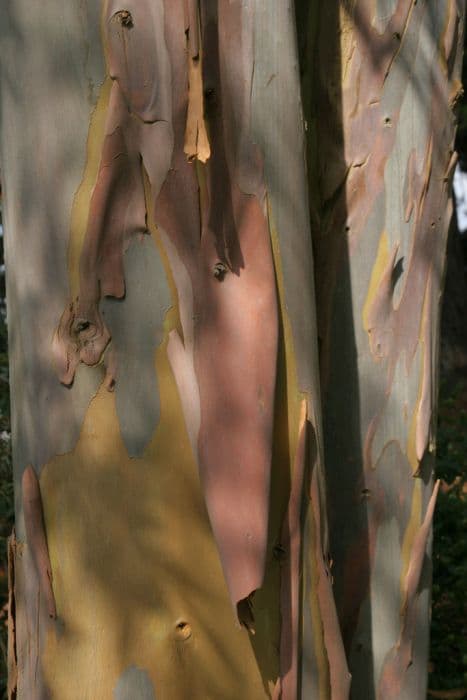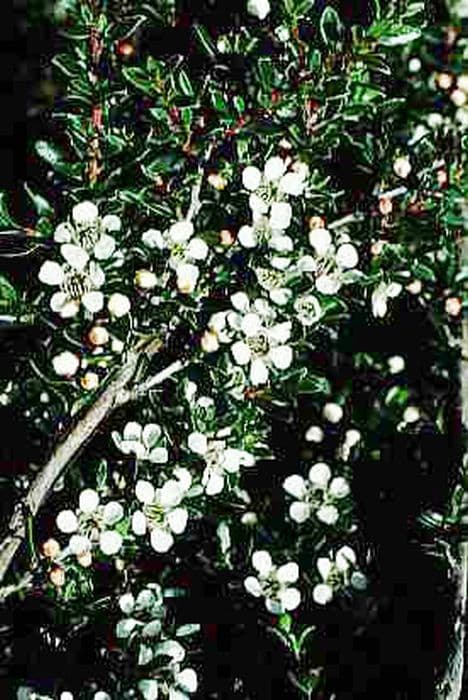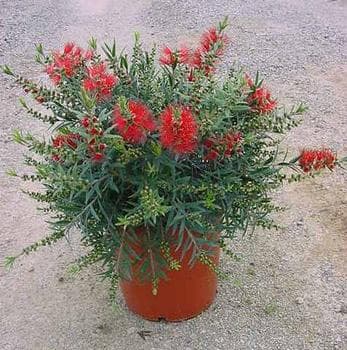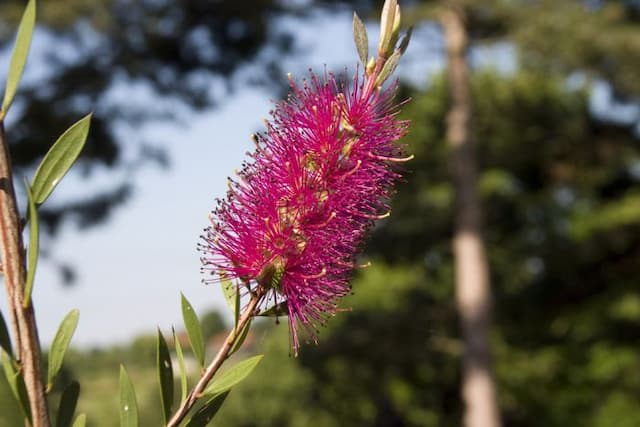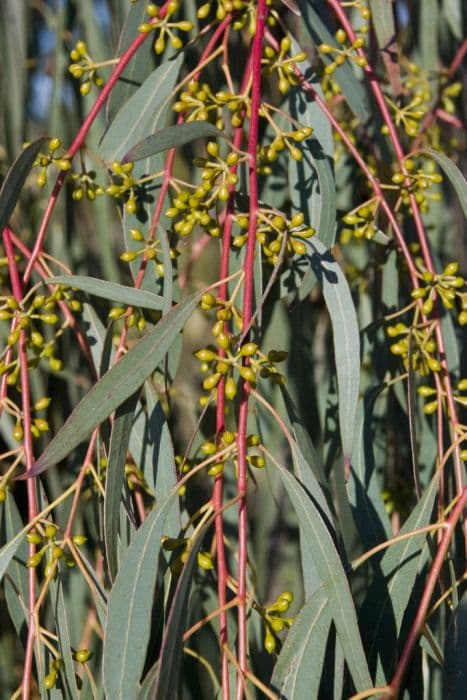Cider Gum Eucalyptus gunnii

ABOUT
Eucalyptus gunnii, commonly known as cider gum, is a hardy, evergreen tree with a distinctive appearance. This plant has smooth bark that can vary in color from grey to white, often shedding in patches and leaving a mottled, smooth surface that is quite picturesque. The leaves of the cider gum are arranged alternately along the stems and have a unique shape and coloration. When young, the leaves are typically round and a striking blue-green hue, with a silvery bloom that can give them a glaucous appearance. As the plant matures, the leaves elongate and become more sickle-shaped, resembling a crescent moon. These adult leaves are a darker green in color and may have a glossy surface. They are often strongly aromatic when crushed, releasing a pleasant fragrance typical of many eucalyptus species. The cider gum flowers are somewhat inconspicuous, white in color, and usually grouped together in clusters. They are followed by woody, cup-shaped seed capsules that can hold a number of small seeds. The general form of the cider gum is upright, with a canopy that can develop a broad or spreading shape, contributing to its visual appeal in a landscape setting. The overall impression of this plant is one of resilience and ornamental charm, with distinct foliage that is both attractive and functional in its native environment.
About this plant
 Names
NamesFamily
Myrtaceae
Synonyms
Cider Gum, Gunnii
Common names
Eucalyptus divaricata, Eucalyptus gunnii var. divaricata, Eucalyptus gunnii subsp. divaricata.
 Toxicity
ToxicityTo humans
Cider Gum is generally considered to have toxic components. Ingesting the leaves or oil can cause poisoning, with symptoms including stomach pain, vomiting, and diarrhea. The oil, specifically, contains eucalyptol, which in higher doses can lead to central nervous system depression, a rapid heartbeat, seizure, and even coma. Ingesting this plant in moderate to large quantities could be highly dangerous.
To pets
Cider Gum is also toxic to pets, including dogs and cats. The essential oils and compounds like eucalyptol that can be found in the leaves are harmful if ingested. Symptoms of poisoning in pets may include salivation, weakness, vomiting, diarrhea, depression, seizures, and on rare occasions, death. Any consumption of the leaves or oil by a pet should be treated seriously, and veterinary assistance should be sought immediately.
 Characteristics
CharacteristicsLife cycle
Perennials
Foliage type
Evergreen
Color of leaves
Blue-green
Flower color
Varies
Height
35 feet 10.7 meters
Spread
25 feet 7.6 meters
Plant type
Tree
Hardiness zones
7
Native area
Tasmania
Benefits
 General Benefits
General Benefits- Ornamental value: Eucalyptus gunnii, commonly known as Cider Gum, is a popular ornamental tree due to its attractive peeling bark and lance-shaped, silver-blue leaves.
- Frost tolerance: It's one of the hardiest eucalypts, able to withstand cold climates and frosts, making it suitable for gardens in cooler regions.
- Drought resistance: Once established, the Cider Gum is quite drought resistant, allowing it to thrive in dry conditions and requiring less water compared to other plants.
- Wildlife support: It provides a habitat and food source for various wildlife, including birds and insects, which are attracted to its nectar-rich flowers.
- Fast growth: Cider Gum is known for its rapid growth rate, which can be beneficial for quickly creating windbreaks or for reforestation purposes.
- Soil stabilization: The extensive root system of Eucalyptus gunnii can help prevent soil erosion, particularly in areas prone to land degradation.
 Medical Properties
Medical Properties- Antimicrobial: Eucalyptus gunnii oil has been found to possess antimicrobial activity against a range of microorganisms.
- Expectorant: The leaves of the plant are a source of eucalyptol, which can help to loosen phlegm and alleviate coughs.
- Anti-inflammatory: Compounds in the essential oil, such as cineole, may reduce inflammation and pain when applied topically.
- Decongestant: Eucalyptus oil from the leaves is used in vapor rubs and inhalants to help relieve nasal congestion.
- Antiseptic: Due to its antimicrobial properties, it can be applied on minor cuts and wounds to prevent infection.
 Air-purifying Qualities
Air-purifying QualitiesThis plant is not specifically known for air purifying qualities.
 Other Uses
Other Uses- Eucalyptus gunnii, commonly called Cider Gum, can be tapped for sap which is then fermented to make a unique type of eucalyptus cider.
- Its dense wood is sometimes used for specialty construction purposes, such as heavy-duty flooring, due to its durability and strength.
- The tree's bark and woodchips can be utilized in landscaping as a decorative mulch that also suppresses weeds and retains soil moisture.
- Frozen eucalyptus gunnii branches are sold as novelty items for floral arrangements, especially in regions where fresh greenery is scarce in winter.
- The leaves of the Cider Gum can be infused in oil and used as a natural insect repellent for warding off pests like mosquitoes.
- Cider Gum leaves, when dried and crushed, are added to potpourri mixes for their pleasant fragrance and preservation qualities.
- Wood from the Cider Gum is sometimes used in the manufacturing of musical instruments like woodwind bodies for their acoustic properties.
- The essential oils extracted from the leaves are utilized in aromatherapy diffuser blends, noted for their fresh and invigorating scent.
- Dried Cider Gum leaves are crafted into eucalyptus wreaths and swags, which are popular as long-lasting and natural home décor items.
- Fresh or dried leaves from Eucalyptus gunnii can be used as a natural dye source for fabrics, imparting a range of green and brown hues.
Interesting Facts
 Feng Shui
Feng ShuiThe Eucalyptus is not used in Feng Shui practice.
 Zodiac Sign Compitability
Zodiac Sign CompitabilityThe Eucalyptus is not used in astrology practice.
 Plant Symbolism
Plant Symbolism- Healing: Eucalyptus is often associated with healing due to its medicinal properties. The Eucalyptus gunnii, or Cider Gum, contains compounds that are beneficial for respiratory health and overall well-being.
- Protection: Eucalyptus has a history of being used to ward off illnesses and bad spirits. It is believed to offer a protective energy to those who use it or plant it.
- Refreshing: The fresh, invigorating scent of the leaves is symbolic of cleansing and rejuvenating both the mind and the atmosphere around it.
- Purification: Its antibacterial properties make the Cider Gum symbolic of purifying spaces, which can be seen in its common use for cleaning and clearing the air.
- Renewal: Because the Eucalyptus tree can regenerate from its stump after being cut, it symbolizes renewal and the ability to bounce back from adversity or illness.
 Water
WaterCider Gum, commonly known as Eucalyptus gunnii, prefers consistent moisture but doesn't like to be waterlogged. During its active growing season in spring and summer, water it once a week with about 1-2 gallons, depending on the size of the plant and the environmental conditions. During the fall and winter months, reduce watering to every two to three weeks, providing 1-2 gallons each time, allowing the soil to dry out slightly between waterings. Ensure that the pot has good drainage to prevent root rot. Overwatering is a common issue, so it's crucial to assess soil moisture before adding more water.
 Light
LightCider Gum thrives in full sun conditions, requiring at least six hours of direct sunlight daily for optimal growth. Plant it in a location where it can receive unfiltered sunlight for most of the day. Eucalyptus gunnii does well in south-facing spots if grown indoors where it can have as much light as possible.
 Temperature
TemperatureCider Gum can tolerate a wide range of temperatures but thrives best when the temperature is between 60-80 degrees Fahrenheit. It can survive brief periods of colder weather, down to about 20 degrees Fahrenheit, but for optimal growth, it should not be exposed frequently to temperatures below freezing. Ideal temperature conditions ensure the healthiest foliage and growth rates.
 Pruning
PruningPruning is essential for Cider Gum to maintain its desired shape and to promote healthy growth by removing any dead or diseased branches. It's best to prune during the plant's dormant season, generally in late winter or early spring. For young trees, light pruning is recommended annually, while mature trees may only require pruning every few years unless there are specific shaping or size containment goals.
 Cleaning
CleaningAs needed
 Soil
SoilThe best soil mix for Cider Gum should be well-draining with a combination of loam, sand, and peat. It should be slightly acidic to neutral, with an ideal pH range of 5.5 to 6.5. Mulch can be added to retain moisture and provide nutrients.
 Repotting
RepottingCider Gum should be repotted every two to three years, or when it becomes root-bound. Younger plants may need more frequent repotting, as they grow more rapidly.
 Humidity & Misting
Humidity & MistingCider Gum thrives in moderate to low humidity conditions and does not require any special humidity adjustments. Average indoor humidity levels are usually adequate for this species.
 Suitable locations
Suitable locationsIndoor
Place Cider Gum in bright light and water moderately.
Outdoor
Plant Cider Gum in full sun and shelter from extreme winds.
Hardiness zone
7-10 USDA
 Life cycle
Life cycleEucalyptus gunnii, commonly known as Cider Gum, begins its life as a seed, which after dispersal germinates in favorable conditions of moisture and temperature. Once germination occurs, the seedling emerges, investing energy in establishing a strong root system and producing its initial leaves, which are crucial for photosynthesis. As the seedling grows, it develops into a juvenile plant with a more formed structure of leaves and stems, differing in shape from mature leaves; this stage also involves the formation of lignotubers at the base for regrowth after damage. The plant soon enters the mature phase, characterized by the elongation of the stem, a change in leaf shape, and the development of a thick, fibrous, and often peeling bark, which protects it from fire and pests. The Cider Gum eventually reaches reproductive maturity, flowering with white blossoms that attract pollinating animals and insects, leading to the production of fruits called gumnuts that release seeds, thus completing its reproductive cycle. Over many years, the Eucalyptus gunnii can become a tall tree, sometimes reaching substantial heights, and is adapted to survive wildfires, capable of regenerating from both seeds and vegetative parts.
 Propogation
PropogationPropogation time
Spring-Early Summer
The most popular method of propagation for Eucalyptus gunnii, commonly known as the Cider Gum, is through seed sowing. The best time to sow seeds is in late winter or early spring. To propagate, fill a pot with a well-draining seed starting mix and sprinkle the tiny seeds on the surface, lightly pressing them into the soil. The seeds need light to germinate, so they should not be covered with soil, but you can gently press them into the medium to ensure contact. Keep the pot in a warm place with plenty of indirect light and maintain the moisture without allowing the soil to become waterlogged. Germination typically occurs within 14 to 21 days. Once seedlings are sturdy enough to handle, they can be transplanted into individual pots to grow on before being planted out.
